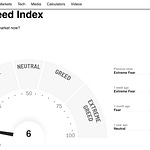To investors,
Finance and investing is based on numbers. Those numbers are used to create metrics. Metrics are put into models, which are used to create insights. Investors take the insights and make directional bets in the market based on their expectation of how the future will unfold.
But what happens when people disagree on math?
That may seem like an absurd question to pose, but let me explain. The Federal Reserve and other central banks around the world are actively engaged in a battle to get inflation under control. What exactly is inflation? It is a mathematical measurement of numbers and metrics.
To be specific — inflation is “a general increase in prices and fall in the purchasing value of money” that is traditionally measured in year-over-year change.
While you wouldn’t think that math would become controversial, the inflation measurement has long been debated. There is the macro argument of whether inflation should be calculated as a simple year-over-year change of prices (as it was before 1980s) or if inflation should be measured using a weighted basket of goods that is changed based on complex calculations (as it is done today).
The difference between these two strategies creates a very different picture of inflation, which is illustrated here.
The blue line is the old way of calculating inflation and the red line is the more modern way. Rather than debate the merits of each approach, I want to simply highlight that there is debate over how to calculate inflation through different methodology. This difference would currently produce one inflation number that is close to 14% and another that is closer to 6%. Obviously that is a big gap.
But the inflation debate over numbers, metrics, models, and insights doesn’t stop there. The nuanced debates around inflation can be even more intense. Most people in financial markets have given up on the macro argument of new vs old methodology, so the new battle ground is on various details of the modern methodology.
For example, the Bureau of Labor Statistics has recently announced that they are changing the methodology for calculating inflation. It isn’t a big change, which is why you probably haven’t heard about it, but the small changes could actually be more dangerous in a high inflation environment.











